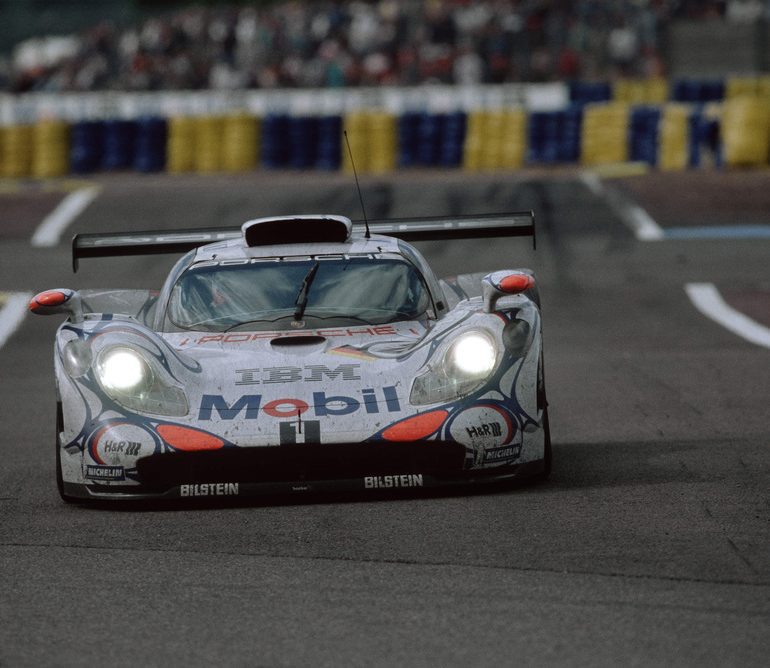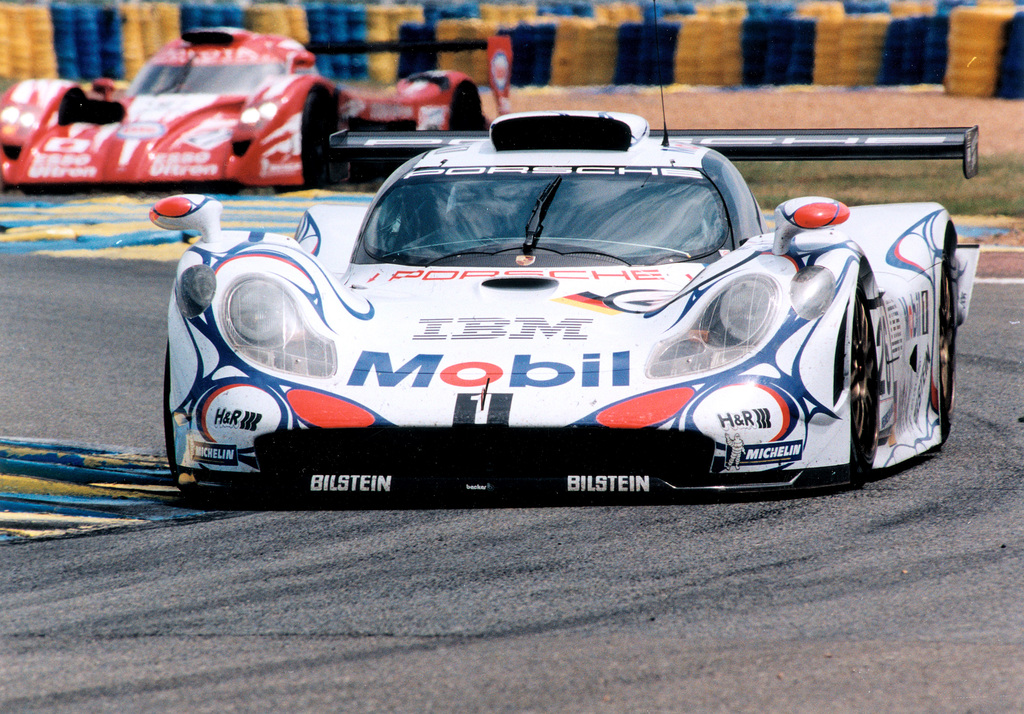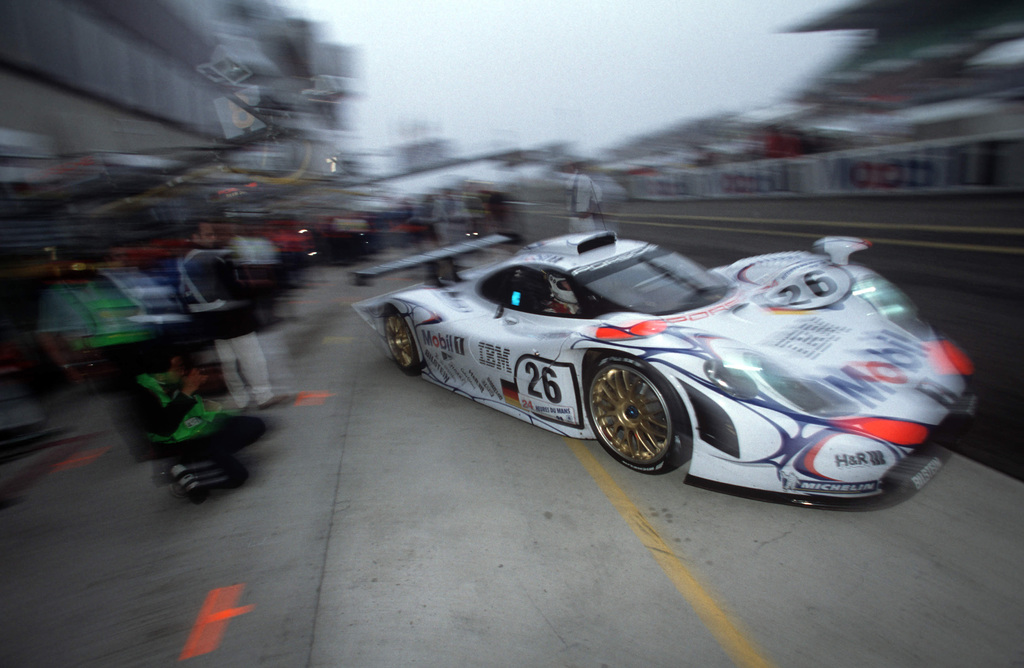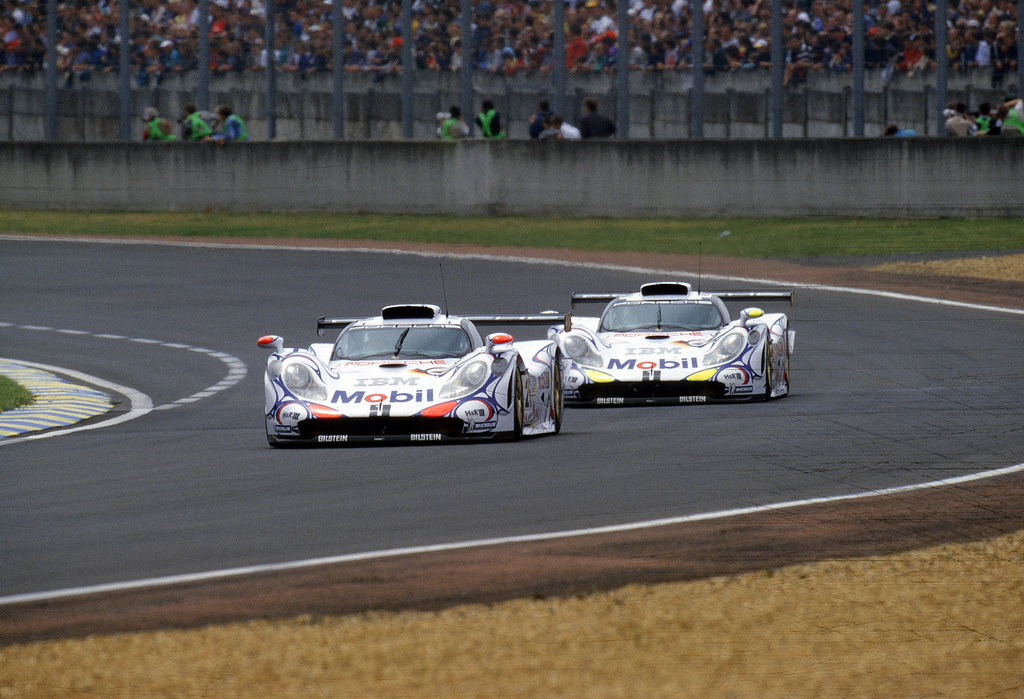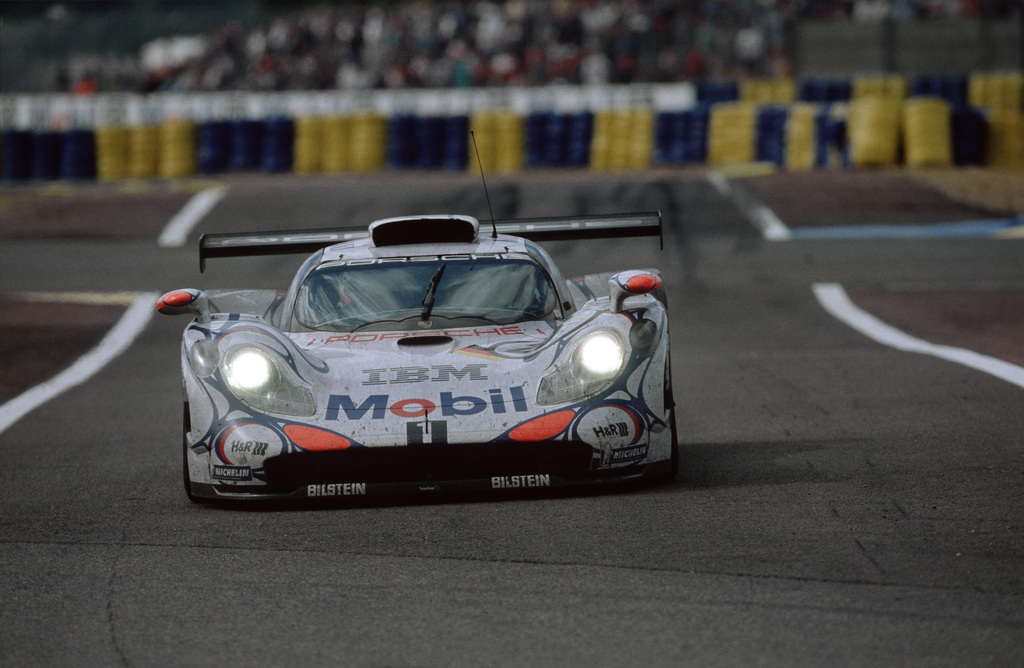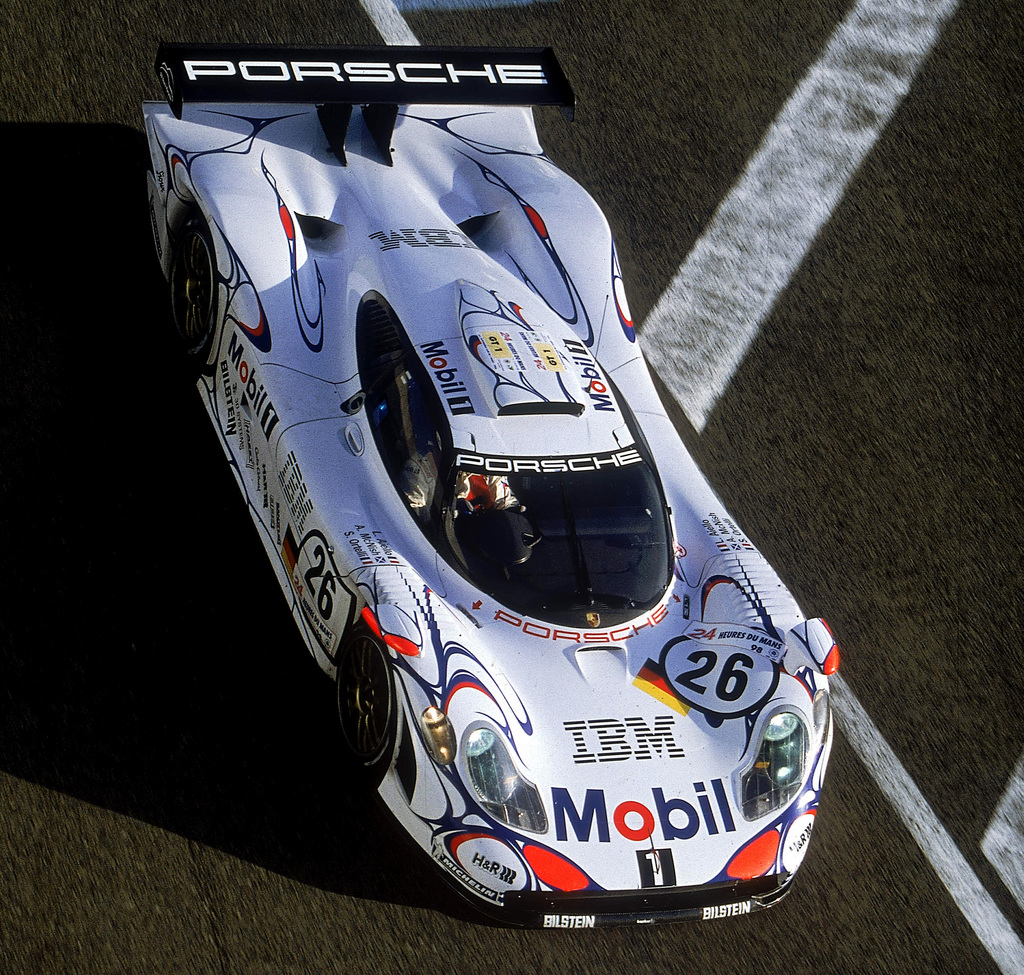1998 Porsche 911 GT1 ’98
1998 Le Mans 24-hour race, the Porsche team celebrated its 16th overall victory in Le Mans with a double win for the 911 GT1 98. On 6th/7th June, the winning car was driven by Laurent Aiello, Allan McNish and Stéphane Ortelli. It was almost 50 years to the day on which the first Porsche sports car saw the light of day.
The 1990s were not good for Porsche when it came to Le Mans success, but in 1998, things turned around with the 911 GT1 98 able to get Porsche back to its winning ways. The 15th Le Mans win came in 1994 with the Dauer 962 (Porsche engineers discover that the 962 C could be modernised and modified to be eligible as a Le Mans GT1 race car, because the required street-legal version already exists: the Dauer 962). It was an awesome race car but it was getting on in age and was no longer competitive enough for an outright win.
That is when Porsche decided on an entirely new, 911-derived design — the Porsche GT1. Porsche knew that it needed something fresh to remain competitive, and that its new racer needed to look like the 911, so with Norbert Singer at the helm the company set to work on the GT1 to compete in the BPR GT Series.
The original design basically took the entire front section of the 993 but with the body being a totally new and custom steel section connected on to carry the engine and transmission that had been turned through 180 degrees and mid-mounted.
The 1996 911 GT1 had a 2nd and 3rd place at the 1996 Le Mans. Several updates (it got 996 derived headlights and other mechanical changes) were made for the 1997 911 GT1 (it was known as the 1997 Porsche 911 GT1 Evolution). There was no finish at Le Mans in 1997.
A Totally New Race Car
Porsche’s resolve was still strong and thanks to race team boss Herbert Ampferer convincing engineering director at the time Horst Marchart to continue development on the GT1, Porsche ended up being quite drastic in their approach. They opted for a clean-sheet design that shared almost no parts with the road cars. There was little pretence of remaining close to the production 911, Porsche was going to build a straight-up Le Mans prototype (FIA regulations required just one ‘Strals’enversion‘ road model to be built).
The GT1 marked a number of firsts for Porsche, one of which was the use of a carbon-fiber monocoque chassis, with the sections and panels constructed by English specialists, CTS. Talented engineer Horst Reitter had designed the carbon tub and he had plenty of experience, having also been responsible for Porsche’s first racing monocoque for the Porsche 956.
The design was 100% CAD driven (for the first time). A quarter-scale model was tested in the wind tunnel, with the data transferred to CAD computers for production of the final car. The final car was checked a second time in Weissach‘s wind tunnel, many further hours being devoted to honing the final shape.
Significant Upgrades
The proliferation of slats and vents that adorned the bodywork was testament to the amount of time spent perfecting the aero and cooling of the ‘98 GT1. A further crucial difference compared to earlier GT1 incarnations was around the weight of the car. Herbert Ampferer had gone on the record saying he wanted the car to be 10% lighter than the ‘97 GT1. The diet and new-car from the ground up approach worked because the ‘98 GT1 weighed only 2,072 lbs (the 1997 GT1 weighed 2,337 lbs).
The carbon-fiber not only helped the car weigh less but it was also a lot stiffer which is important in all race cars when it comes to handling. The new car was also slightly longer and wider and also sat a little lower too. The wheelbase had also grown. There was also a large, adjustable plastic rear wing, while the nose was noticeably lower, a development achieved by relocating the cooling radiators from the centre to the outer edges of the front end. It even got cool supercar hinged doors for the first time.
The engine was largely the same as the previous GT1s. A water-cooled, 3.2 liter flat six unit adapted from the 962 race car, but fitted with one-piece aluminum cylinder heads from the Porsche 959. The block was also in aluminum, and four valves per cylinder were operated by chain-driven camshafts. While the original 74 mm stroke was retained, the bore was enlarged from 95 mm to 95.5 mm for a 3,198cc capacity. Also retained were the pair of KKK K27.2 turbochargers fed by a massive scoop on the roof and blowing through twin intercoolers, along with a TAG 3.8 engine management system that controlled multi-point sequential injection and cylinder-selective knock control.
The result was around 550 hp at 7,200 rpm and 465 lb/ft of torque at 5,000 rpm. The transmission was upgraded with the dog-clutch six-speed changing for a conventional shift pattern for a sequential arrangement more suited to endurance racing. It had an additional pump for improved lubrication, an oil to-water heat exchanger, and a new triple-disc carbon clutch.
Other notable improvements were the front suspension, where an entirely difirerent set-up was installed and gave Porsche race engineers a lot more wiggle room in terms of setting changes and tuning. Double wishbones, pushrods and transverse coil springs with Bilstein dampers were also part of the ‘98 GT1 set up. The same suspension arrangement was employed at the rear — there was an anti-roll bar at both ends. The car handled better as a result but perhaps even more important was that this set up necessitated the move of the 100 liter safety cell for fuel to a position between the bulkhead and engine, which was a vast improvement when it came to weight distribution. Hydraulically assisted steering also featured, while the Michelin tyres 27/67—19 front and 31/70-19 rear — sat on ll.5×19 inch front and 13×19 inch rear single—piece BBS rims.
The ’98 GT1 & The 1998 Le Mans
Compared to what had gone before, the 1998 GT1 was a hugely impressive package, and Porsche had left no stone unturned when it came to meeting the challenges posed by the likes of Toyota, Nissan and Mercedes Benz. At Le Mans it was Mercedes-Benz that took pole and 3rd positions on the grid, split by a Toyota GT-One. Porsche had to settle for fourth for #25 and 5th for #26.
Both cars spent time in the pits for minor repairs and with 90 minutes of the race remaining it looked like Toyota would take the chequered flag. But it was struck by transmission failure, meaning the two Porsche spent the last hour in one-two formation and that’s how it finished. The GT1 conquered le Mans and delivered Porsche a fitting present on its 50th birthday. The car of McNish, Aiello and Ortelli crossed the line in 1st place, bringing Porsche a historic 16th victory at the toughest race in the world.
Porsche 911 GT1 ’98 Specs & Performance
| Car | Porsche 911 GT1 ’98 |
| type | Racing Car |
| built at | Germany |
| engine | Twin Turbo Flat-6 |
| valvetrain | 4-Valves / Cyl |
| displacement | 3200 cc / 195.3 in³ |
| bore | 74.4 mm / 2.93 in |
| stroke | 95.5 mm / 3.76 in |
| power | 410.1 kw / 549.9 bhp @ 7200 rpm |
| specific output | 171.84 bhp per litre |
| bhp/weight | 578.84 bhp per tonne |
| torque | 630 nm / 464.7 ft lbs @ 5000 rpm |
| body / frame | Carbon Fibre |
| driven wheels | Mid Engine / RWD |
| front tires | 305/645-18 |
| rear tires | 325/705-18 |
| front brakes | Carbon Discs |
| front wheels | F 45.7 x 30.5 cm / 18.0 x 12.0 in |
| rear wheels | R 45.7 x 33.0 cm / 18.0 x 13.0 in |
| steering | Power Steering |
| curb weight | 950 kg / 2094 lbs |
| length | 4890 mm / 192.5 in |
| width | 1990 mm / 78.3 in |
| height | 1140 mm / 44.9 in |
| transmission | 6-Speed Sequential |
911 GT1 ’98 Videos
Clearly the 1998 GT1 is not a car you can just rock up to a dealership and buy, so finding good videos online is an exercise in search events like Goodwood or old archive footage from back in the day. The good news is that we found a few solid Porsche 911 GT1 ’98 videos that we shared below. Enjoy.
911 GT1 ’98 Pictures & Gallery
When sharing 911 GT1 ’98 pictures and photos we decided to stay away from museum stills and instead showcase the 1998 GT1 in action, on the race track.


